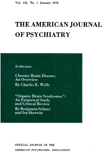Abstract
Phenyltoloxamine produced predominantly a sedative-hypnotic pattern. Physiologically, there was a slight increase of respiration, decrease in muscle tension, lowering of the systolic (but not diastolic) blood pressure, marked pupillary constriction. Pulse rate and finger skin temperature were not significantly affected. Significant impairment of psychomotor functions occurred at peak of the drug action, and was manifested by a decrease in rate of motor activity discharge and impairment of visuomotor coordination and steadiness. The speed of mental processes was not impaired, but accuracy was somewhat decreased. Learning of competitive paired associate material was improved. The Ss. were aware of the marked effects of the drugs at the peak of drug action, usually 4-5 hours after ingestion. They experienced this as unpleasant because of the degree of sedation and impairment of motor function. The marked sedative and soporific effect approached hypnotic proportions and was associated with slowing of speech, impaired voluntary motor control and coordination, and subjective feelings of slowed thinking, disrupted concentration, a loss of ability to study and lethargy as well as reduction in anxiety. The peak action, at 4-5 hours after ingestion of the drug, was achieved with a relatively abrupt onset and cessation. Many of the Ss. reported a sense of relaxation and an increase in the capacity to do mental work which came after peak action and continued for another 4-8 hours. During the peak action of drug there was some decrease in rapport, a lessening of emotional responsiveness, and a decrease in the quality of verbal associations.
Reserpine produced predominantly vegetative effects with only slight effect on state of consciousness and motor activity. The rate of respiration decreased, a rise in finger skin temperature was recorded, muscle tension increased and diastolic blood pressure decreased without change in systolic pressure. Pupils were slightly constricted. Psychomotor test performance was slightly increased, but mental speed remained unaffected. Accuracy of serial addition was slightly increased. Competitive paired associate learning was greatly impaired. While the Ss. were, according to the psychiatrist's observations, mildly sedated, inhibited in facial expressiveness, and slowed in overall psychomotor reactivity, they frequently reported that they felt "no change". The visceral discomforts attracted their attention more frequently. This apparent lack of awareness of the changes in their behavior noted by the psychiatrist is similar to the quality of the drug action called "indifference" by Denniker(17) and "isolation from environment" by Berger(18). Three Ss. reported feelings of depression. The effects on rapport and verbal associations were variable. Sedation effects occurred at early hours and were followed in 8 to 18 hours by awareness of uncomfortable visceral symptoms.
Following the administration of placebo the Ss. reported a reduction of anxiety, an increase in relaxation, a slight increase in respiration and a slight decrease of muscle tension. Psychomotor performance and accuracy in mental function were increased, probably caused by a combination of practice and relaxation. When competitive associate learning after placebo was compared with learning under the other agents, it was noted that associative learning was facilitated under phenyltoloxamine and retarded with reserpine. As the placebo day progressed, the subjects reported mild sedation and relaxation, but were able to study and read. This was associated with a concomitant improvement in rapport, emotional expressiveness and verbal associations.
Many investigators have similarly reported such changes subsequent to the administration of a placebo.
The "drug action profiles" (characteristic pattern of action) of the three agents are shown in Fig. 4.[see source PDF for figure 4.]

